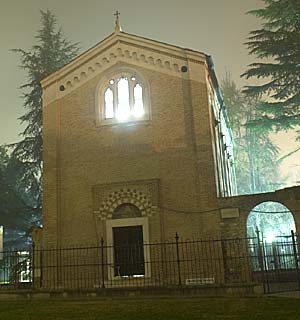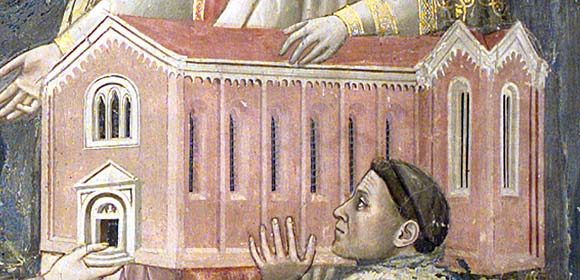 |
 |
|
The Scrovegni Chapel, Padua
|
 |
The
known dates
Not many documented dates regarding the Chapel have so far been found.
There exists the deed of purchase (February 6, 1300) of the land, including
the remains of the ancient Roman arena, on which the Chapel was built;
therefore, we know the name of the owner: Enrico Scrovegni. However, there
is no direct reference to the construction and the decoration of the building,
nor the dates when they were carried out, and their author (or their authors).
The seller, Manfredo Dalesmanini, seems to have had an urgent need for
cash, and Enrico Scrovegni purchased from him the whole Arena complex,
which was of considerable value since it was made up of a number of buildings
including a palazzo with adjacent hot baths and other buildings, stables
for horses, and two towers or "dongioni" erected on the two
entrance gates, facing towards the Eremite monastery and the river.
From a document dated March 1, 1304 - an indulgence granted by Pope Benedict
XI to the faithful who visited the Church of the Blessed Virgin Mary of
Charity at the Arena - we can reasonably assume that, by that date, the
Chapel was usable as a place of worship and therefore at least the walls
and roofing had been completed. There is also an inscription on a stone
plaque (now lost) which states that the Chapel was dedicated on March
25 of the previous year (1303).
On January 9, 1305, the Augustinian friars from the nearby Eremite monastery
fired off an angry protest demanding that the work be stopped since the
building did not correspond to the original plan approved by the bishop.
The Eremites felt that their interests had been severely threatened by
the transformation of what should have been a private oratorio into a
church open to the general public, therefore in direct competition with
their own convent church. The final straw was the erection of a campanile
which they viewed as a thoroughly sneaky move.
On March 16, 1306, the Grand Council of Venice agreed to lend Enrico Scrovegni
some "materials" (thought to be tapestries, sacred vestments
or altar cloths) from St. Mark's Basilica for the consecration of "his
chapel in Padua". It seems clear that the chapel in question was
the Arena Chapel and, similarly, that the ceremony of dedication took
place on the Feast of the Annunciation (March 25), which that years was
characterised by the performance of a Sacred Representation in front of
the new building.
 |
| Model of the Chapel offered up to the Virgin
Mary, detail of The Last Judgement, Scrovegni Chapel, Padua |
 |
Modifications
while work was in progress
There is no doubt that the building was altered
while work was in progress - this can be seen indirectly not only from
the
scale model of the Chapel offered up by Enrico to the Virgin Mary
in the fresco of the Last Judgement, but also from traces
that evident in the body of the building itself.
As for the Chapel's subsequent history, very little is known about it
up until the 19th century when it risked being destroyed through neglect
on the part of the new owners (the Foscari Gradenigo family) which led
to the collapse of the portico on the facade and of the palazzo built
by Enrico.
These events had a negative effect on the Chapel which was left without
support and without protection on the left side and on the facade. The
acquisition of the Chapel by the City Council in 1881 ensured that it
survived, but both the building and the frescoes had been seriously damaged.
|












